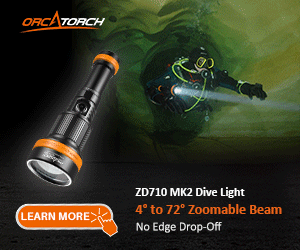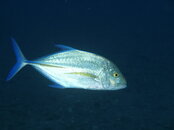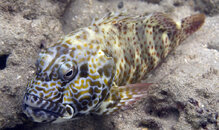gary-ramey
Contributor
Over the next week or so I'm going to start putting up photos taken this weekend in Hawaii. I took my Oly E-410 diving for the first time. I'll start with a write up and then follow with photos in due time. As a reference point here is a quick user bio, equipment list and dive report. I'm 43, male, use glasses with a mild prescription, been taking photos underwater for about 2 years, and started with an Olympus SP-350. The conditions were not good for taking photos as there was a lot of sediment kicked up on all 4 dives. Viz was about 20-40ft on most dives. I'll be posting the jpegs straight from the camera. As an added sidenote, I took a lot of photos just to see how the camera performed and wasn't overly excited about getting the correct composition on a shot. I also made a few amateur mistakes with depth of field and other technical details. So the shots themselves are unspectacular but do show the performance of the camera in the hands of an average joe. The equipment used Oly E-410, Oly fl20 flash with housing, Inon Z-240, 14-42mm kit lens, PPE-05 port and the PT-E03 housing.
In the should have done it sooner catagory: INON..wow what a strobe.
Loved it
1. No shutter lag is a beautiful thing. I don't know how many shots that I missed with the SP-350 just because it wouldn't prefocus or take the picture fast enough. Butterfly fish, zig-zaggy little guys, and the candid see-it-and-gotta-have-it shots were all missed. Albeit the SP-350 made me a better, more patient fish stalker but if I missed with the first shot it was over. If I could see it and manage to get the camera to my face fast enough I could take the shot with the Oly E-410.
I don't know how many shots that I missed with the SP-350 just because it wouldn't prefocus or take the picture fast enough. Butterfly fish, zig-zaggy little guys, and the candid see-it-and-gotta-have-it shots were all missed. Albeit the SP-350 made me a better, more patient fish stalker but if I missed with the first shot it was over. If I could see it and manage to get the camera to my face fast enough I could take the shot with the Oly E-410.
2. The 14-42mm lens - I was originally a little worried about losing the versatility of a the SP-350 which was the strength of that camera. After 5 minutes in the water, the 14-42mm lens gave me the feeling that the only capability I might be giving up for one dive would be the super macro. Furthermore the manual zoom, crisp shots and quick focusing lens more than made up for the lack of super macro capability. It comfortably goes from WA to Macro while not pressing the limits at either end. You could take this lens on a dive and get a nice shot of a shark in one second while turning and zooming in on a nudibranch the next.
3. The crispness of the photos I think is what really got my attention. About 95% of the out of camera shots came out in focus. With my old Oly SP-350 that number was somewhere between 75% if you count the shots you never took because the camera couldn't lock focus.
4. Write speed - While you still have to wait a few seconds for the strobes (fl20 takes about 4 seconds to recharge after a full dump) you can still fire away with the camera. One after another. In shallow water you could literally fog the housing by firing away as many shots as you want, all crisp and in focus.
5. Size and weight - underwater this setup is very neutral. I'd estimate around 1lb or less of negative buoyancy. The ergonomics of the button layout is like most of the OEM housings from olympus with a button for almost every function with only 1 notable button missing.
I hated it
1. It took 2 hands to change the aperture in manual mode. With the camera out of the housing this is a breeze. You simply depress a small button near the shutter and turn the thumbwheel. Underwater the thumbwheel is a knob and the small button is not farther than my index finger from the grip. So I literally had to take my left hand and depress the button while turning the knob with my right with the camera port tucked between my knees or elbows. Its not easy to do. While I don't fore see this causing me to miss any shots its still a pain.
2. Port cover - Its a rubber cap. I've already lost it underwater once and had to spend about 15 minutes snorkelling the path I came and went in order to find it. There's no lanyard on it so when you put it back on for entry or exit you better keep a hand on the port cover.
While this shot isn't an eye opener it remained my favorite of the trip because its of a Jack that came cruising by fairly fast. It would have been an impossible shot with my old camera due to the speed at which the fish was cruising along with the moment I noticed the fish being only a few feet away.
In the should have done it sooner catagory: INON..wow what a strobe.
Loved it
1. No shutter lag is a beautiful thing.
2. The 14-42mm lens - I was originally a little worried about losing the versatility of a the SP-350 which was the strength of that camera. After 5 minutes in the water, the 14-42mm lens gave me the feeling that the only capability I might be giving up for one dive would be the super macro. Furthermore the manual zoom, crisp shots and quick focusing lens more than made up for the lack of super macro capability. It comfortably goes from WA to Macro while not pressing the limits at either end. You could take this lens on a dive and get a nice shot of a shark in one second while turning and zooming in on a nudibranch the next.
3. The crispness of the photos I think is what really got my attention. About 95% of the out of camera shots came out in focus. With my old Oly SP-350 that number was somewhere between 75% if you count the shots you never took because the camera couldn't lock focus.
4. Write speed - While you still have to wait a few seconds for the strobes (fl20 takes about 4 seconds to recharge after a full dump) you can still fire away with the camera. One after another. In shallow water you could literally fog the housing by firing away as many shots as you want, all crisp and in focus.
5. Size and weight - underwater this setup is very neutral. I'd estimate around 1lb or less of negative buoyancy. The ergonomics of the button layout is like most of the OEM housings from olympus with a button for almost every function with only 1 notable button missing.
I hated it
1. It took 2 hands to change the aperture in manual mode. With the camera out of the housing this is a breeze. You simply depress a small button near the shutter and turn the thumbwheel. Underwater the thumbwheel is a knob and the small button is not farther than my index finger from the grip. So I literally had to take my left hand and depress the button while turning the knob with my right with the camera port tucked between my knees or elbows. Its not easy to do. While I don't fore see this causing me to miss any shots its still a pain.
2. Port cover - Its a rubber cap. I've already lost it underwater once and had to spend about 15 minutes snorkelling the path I came and went in order to find it. There's no lanyard on it so when you put it back on for entry or exit you better keep a hand on the port cover.
While this shot isn't an eye opener it remained my favorite of the trip because its of a Jack that came cruising by fairly fast. It would have been an impossible shot with my old camera due to the speed at which the fish was cruising along with the moment I noticed the fish being only a few feet away.






